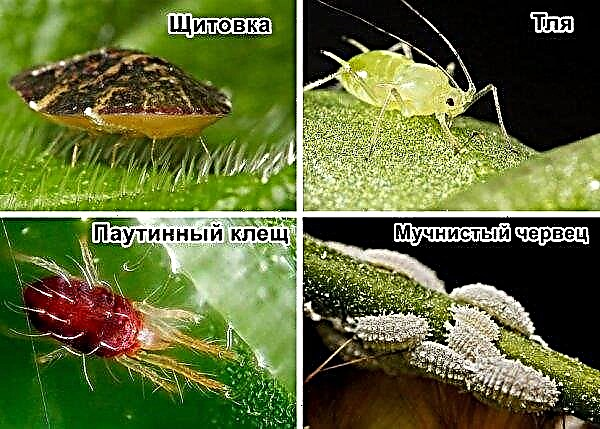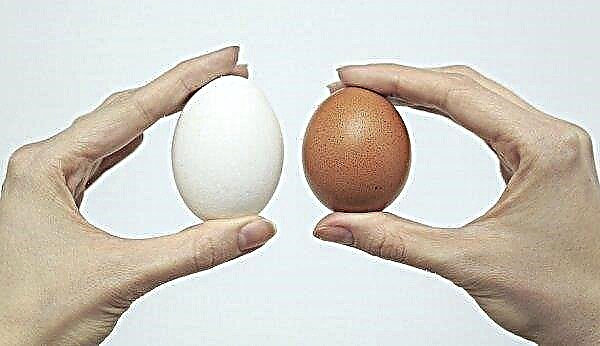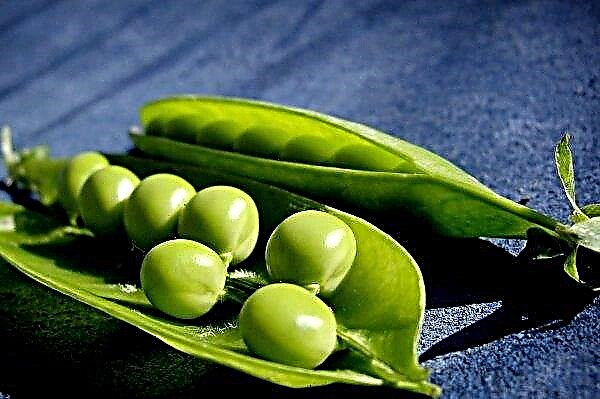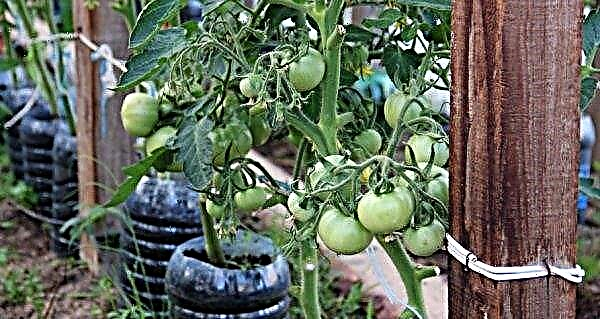Since bees and wasps have one ancient ancestor - a predatory wasp, in appearance they are similar to each other, therefore they are often confused. After reading the article, you will learn how to distinguish between these two insects, and what is the difference between them.
Did you know? According to archaeological research, humans “domesticated” bees 5–6 thousand years ago. For their maintenance in those days weaved from rods or made hives from boards. They were also kept in clay vessels.
General description
To begin with, we offer to get acquainted with these species and learn about their biological features.
Os
A wasp, like a bee, belongs to the order Hymenoptera. These insects form a separate family - real wasps. The initial habitat of their habitat was the Northern Hemisphere. Over time, they were brought to Australia and New Zealand. These yellow-black insects have four webbed wings. There is a head, body, 6 paws. The belly is fusiform or barrel-shaped, covered with hairs, colored in stripes, with a short sting at the end. On the head, on the sides, there are 2 complex eyes, on the top of the head are 3 simple eyes, as well as antennae, which serve as organs of touch, and the oral apparatus with strong strong jaws.
The belly is fusiform or barrel-shaped, covered with hairs, colored in stripes, with a short sting at the end. On the head, on the sides, there are 2 complex eyes, on the top of the head are 3 simple eyes, as well as antennae, which serve as organs of touch, and the oral apparatus with strong strong jaws.
Bees
Bees form a family of real bees, numbering about 520 genera. These are insects useful to humans, due to the fact that they pollinate plants and make honey. They live on all continents except Antarctica. They live in places where honey plants grow. Their body consists of a head, chest, abdomen, limbs, two pairs of membranous wings. On the head there are 2 complex and 3 simple eyes. The mouth consists of the upper lip and upper jaws. The lower lip and lower jaw form the proboscis.
Their body consists of a head, chest, abdomen, limbs, two pairs of membranous wings. On the head there are 2 complex and 3 simple eyes. The mouth consists of the upper lip and upper jaws. The lower lip and lower jaw form the proboscis.
What is the difference between wasps and bees?
At first glance, these insects are similar. However, if you look closely, you can notice a lot of external differences that are present in the color scheme of the body, size, body structure. They also have different lifestyles, ways of eating, they build nests in different ways, and respond to critical situations. Their significance for man and nature is also different.
Did you know? An adult healthy person who does not have an allergy can die from 500–1100 bee stings. In medical practice, cases have been recorded when a fatal outcome occurred and after 100 bites during an attack by a bee swarm.
External differences
We offer you to learn in more detail how each of these insects looks, and which of them is larger in size.
Coloring
The wasp has a black body. Her chest is streaked with yellow spots. On the belly there are extensive patches of yellow. Paws are also yellow. The color of this insect is very contrasting, well distinguishable from afar. The bees are not so contrasting. They also have black and yellow stripes, however, they are more faded. Paws of honey insects of black color.
Dimensions
Wasps differ in average size: females of an ordinary species grow up to 1.8 cm, working individuals up to 1.4 cm. The largest of the genus are hornets - they can be up to 5.5 cm in length, and on average grow up to 2.5 –3.5 cm. Their honey relatives are slightly smaller in size, but it all depends on the type and gender: the body of the smallest species - dwarf - reaches a length of 2 mm, and the largest - 3.9 cm. The size of the working honey bee is 1 , 4 cm, uterus - 2 cm, drone - 1.5-1.7 cm.
Body structure
The differences between the wasp and the bee are clearly visible in the structure of their bodies:
- The bee body is round in shape, and the hornet is elongated.
- Wasps have a thin interception between the chest and belly. It is easy to spot. Their honey relatives have such an interception, but are weakly expressed.
- Wasps have a smooth body, while in a bee it is well pubescent.
- The wasp jaws are larger and stronger.
- The paws of the wasps are more elegant.
Important! Bees and wasps react sharply to the smell of released poison when they bite, so relatives nearby, smelling it, can join the attack on humans.
Differences in Behavior and Lifestyle
The species in question are social insects. This means that they live in large families. In order to search for nectar and pollen, they fly out in groups: bees, several individuals, and wasps, 20-30 each. The latter - can create colonies of 1 thousand or more representatives. Although there are single species. Bees are toilers. Throughout their short life, working individuals make flights in search of food, equip a nest, feed and protect the uterus - the main female. A fertilized uterus is the only one who is able to winter in winter in order to breed offspring in spring. In wasps, the family is arranged differently. Toilers do not care so much for the uterus and do not protect it. She hibernates alone.
A fertilized uterus is the only one who is able to winter in winter in order to breed offspring in spring. In wasps, the family is arranged differently. Toilers do not care so much for the uterus and do not protect it. She hibernates alone.
Related insects fly differently. So, bees do it smoothly, and wasps are choppy and fast, sometimes hanging in the air for a while. In nature, bees perform the function of pollination of plants.
For a person, they are important as producers of healthy products: honey, royal jelly, wax. Wasps are also pollinators, and also natural enemies of many insects that harm forests. For a person they do not represent any benefit. Pests are considered due to damage to the harvest of sweet fruits and berries.
Important! If a wasp or a bee stings an allergic person, he urgently needs to give an antihistamine and take him to the hospital.
Features of the nutrition of species
One of the significant differences between these species is the nature of the diet. Honey insects feed exclusively on nectar and pollen. They use the first product for energy. And the second - as a source of proteins and other substances necessary for life. They collect food using a long proboscis. Transported in a special way equipped with hind limbs, which form a "basket". Their motley relatives, in addition to such food, can also eat vegetation, the pulp of fruits and berries. At the same time, they often fight aggressively for food. Often during skirmishes, they can kill honey relatives to win their honey from them. There are predatory species that can eat other insects, larvae, carrion (small rodents, birds).
Their motley relatives, in addition to such food, can also eat vegetation, the pulp of fruits and berries. At the same time, they often fight aggressively for food. Often during skirmishes, they can kill honey relatives to win their honey from them. There are predatory species that can eat other insects, larvae, carrion (small rodents, birds).
Behavior of insects at the time of danger
In case of danger, both insects are protected by a sharp sting. The honey plant launches it somewhat less frequently, only for protection. But his aggressive relative wields them much more often, and he may be the first to go into conflict, for example, entering the fight for a piece of edible food with a person. Her attempts are annoying. If a person actively shrugs it off, it stings. The sting can also be used in case of an unpleasant smell, for example, a deodorant or perfume, as well as for no apparent reason.
Differences between the sting and the nature of bites
Surely, at least once in your life you have been bitten by one of these insects and you know that this feeling is not pleasant. If you are interested in which of them stings harder - most likely a wasp. This is explained by the different structure of the sting and the nature of the bite. In a bee, it has many notches and a knot at the end. Having stuck it in the human skin, the insect can no longer extract it, therefore it leaves. It flies away itself, but does not live long, without a sting it dies. The wasp sting looks different - the notches on it are much smaller, and there is no knot on the tip. When bitten, it does not remain in the body of the victim. The insect can sting him repeatedly. Therefore, the bite causes severe pain. In addition, a wasp, in addition to a sting, can use its jaws during an attack. The level of pain from a bite of a representative of a paper species is measured by 3 points on a five-point scale.
The wasp sting looks different - the notches on it are much smaller, and there is no knot on the tip. When bitten, it does not remain in the body of the victim. The insect can sting him repeatedly. Therefore, the bite causes severe pain. In addition, a wasp, in addition to a sting, can use its jaws during an attack. The level of pain from a bite of a representative of a paper species is measured by 3 points on a five-point scale.
Nest structure
Honey representatives of the family equip their home with wax, making honeycombs of the correct hexagonal shape. In the apiary, they are equipped with special houses - hives. In the wild, they live in hollows of trees, in crevices of rocks. Wasps are used to build parchment nests. They get it by chewing wood or plant cellulose. Wasp nests are oval. They are mounted on trees, buildings, in the soil. Despite the external similarities of a common ancestor, bees and wasps have a number of differences regarding the structure of the body, the nature of food, lifestyle, home improvement, family hierarchy, and behavior in an emergency.
Wasp nests are oval. They are mounted on trees, buildings, in the soil. Despite the external similarities of a common ancestor, bees and wasps have a number of differences regarding the structure of the body, the nature of food, lifestyle, home improvement, family hierarchy, and behavior in an emergency.












